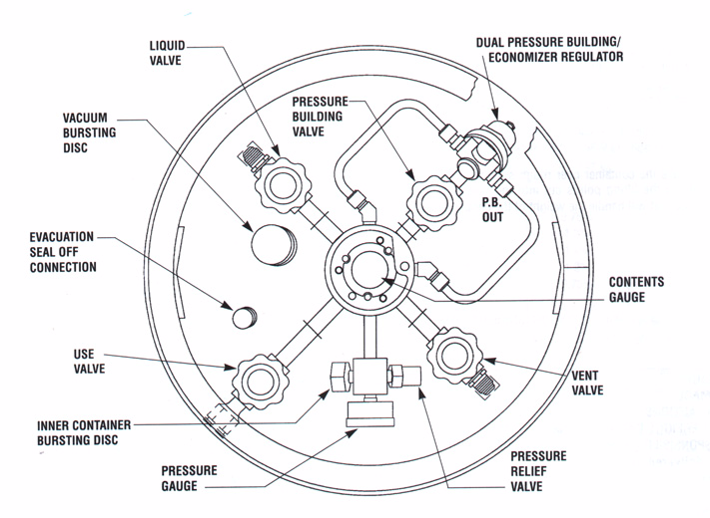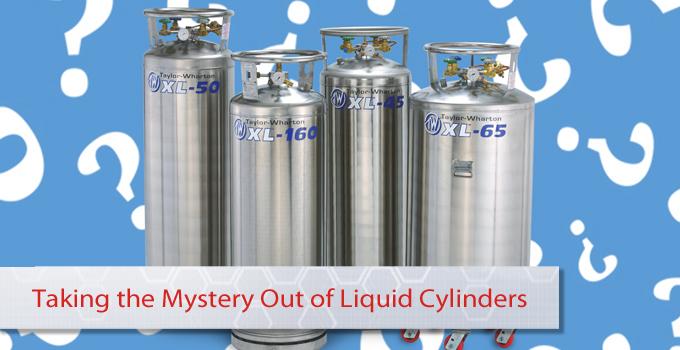| Many of our customers rely on liquid cylinders as their sources for cryogenic supply or for high volume gas supply. These cylinders are unique and mysterious. The more familiar our customers are with the functionality and operation of liquid cylinders, the better this package works in their favor. Let us begin our mystery-solving with definitions. Although liquid cylinder and liquid Dewar are often used interchangeably, they are technically two different things. Liquid cylinders are pressurized containers specifically designed for portable large volumes of cryogenic liquid. Liquid cylinders allow the operator to withdraw liquid or gas. A liquid cylinder has valves for filling and dispensing the cryogenic liquid, and a pressure relief valve with a bursting disk as backup protection. Dewars are non-pressurized vessels, typically with a loose-fitting cap or lid that allows excess pressure to vent. Liquid Dewars are designed like Thermos Bottles and are often used in laboratories to transport small amounts of liquid nitrogen, for example. |

There is a lot happening on the top of a liquid cylinder. Understanding each component and its function assists in the safe and effective operation of the container.
The pressure gauge is a popular reference point, indicating gas pressure inside the inner tank. Pressure within the tank will constantly increase as the laws of physics transform the cold liquid into warmer gas. This pressure assists the withdrawal of liquid or gas from the cylinder. In most cases, the pressure inside the tank must be artificially maintained, hence the pressure building circuit.
Opening the pressure building valve draws liquid through a line that runs from the bottom of the inner tank and passes it through the pressure building coil attached to the inside wall of the outer tank. As liquid passes through the coil, it is vaporized by the heat of the outer tank. The resulting gas is fed through the pressure building valve and pressure building regulator, into the inner tank causing a rise in pressure.
After pressure has been built inside the liquid cylinder, you can draw gas by opening the gas use valve. Opening this valve lets the pressure in the tank force liquid up a withdrawal line, and then down into a vaporizer coil. Heat is conducted through the outer tank walls to the vaporizer. As the liquid moves through the coil, it is vaporized by this heat. The resulting warm gas flows up through the gas use valve out to the application to complete the vaporizer circuit. Often a single-stage regulator is attached directly to the gas use valve to reduce the supply pressure to match the application’s requirements.
If the liquid cylinder sits dormant for several days, pressure will continue to rise at a rate of 30 psi per day when heat permeates the inner tank. This heat vaporizes the liquid and causes the pressure to slowly rise. The pressure builds up to the pressure control valve, the valve opens, and gas is vented to the atmosphere. This is why liquid cylinders often have a “use it or lose it” design, and are not intended to hold cryogenic liquid for extended periods of time like a microbulk or bulk tank.
To minimize losses from this venting, the cylinders have an economizer circuit. The regulator allows gas from the top of the cylinder to flow through the internal vaporizer out of the gas use valve to your application. This reduces pressure in the inner tank and minimizes losses from venting. When pressure normalizes, the economizer regulator closes and the cylinder delivers gas by drawing liquid through the vaporizer circuit. The economizer regulator should have a set pressure 15 psi higher than the pressure building regulator. The pressure relief valve is mounted on the same stem as the pressure gauge. Often set to open at 230 psi, the pressure relief valve works in conjunction with an inner container bursting disk. As a secondary relief device, there is also a vacuum bursting disk on the outer tank to protect the space between the inner and outer tanks from high pressure.
To withdraw liquid from your liquid cylinder, first close the pressure building and gas use valves. Then open the liquid valve to allow head pressure in the tank head to force liquid up the withdrawal tube, and out of the container.
Liquid withdrawal should be done at low pressure to prevent flash losses. During transfer, if pressure in the tank is higher than the normal liquid withdrawal pressure, open the vent valve to lower the pressure. Liquid is typically withdrawn at less than 15 psi.
When filling an open container, if a greater liquid withdrawal pressure or rate is required, a qualified service technician can adjust the pressure building regulator.
In the center of the cylinder is a contents gauge. This can be a float-type gauge that provides an approximate indication of the tank’s contents. If you need to know exactly how much liquid is in your cylinder, use a digital gauge.
Because the pressure building vaporizer contains cold liquid, it cools the outer tank and it is perfectly normal for frost to form on the outside of the cylinder. During a prolonged high-draw, the outside of the cylinder will be very heavily frosted. As frost turns to water, make sure your liquid cylinder is not in a location where flooring can be damaged. Many customers find comfort in a drip pan.
For onsite consultation or support, contact us. When multiple liquid cylinders are required, ask us about microbulk. Our gas experts will explore the pros and cons of each mode with you and your team.
Source: Taylor-Wharton, US Tank, WestAir

